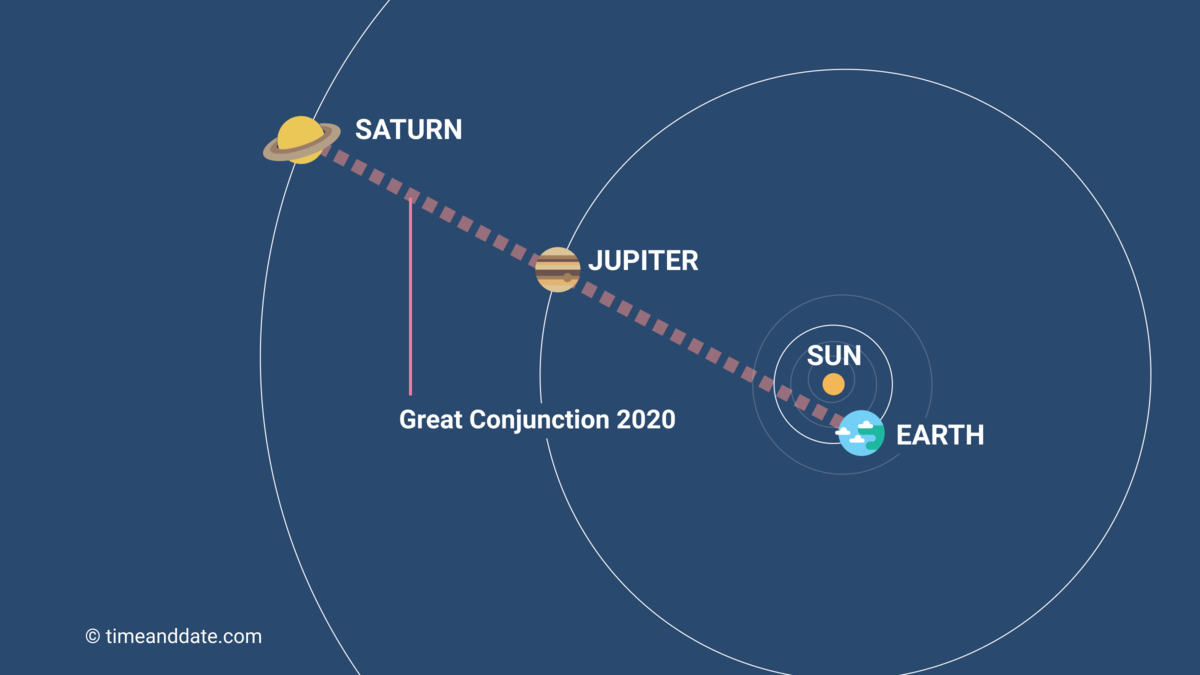Conjunctions in astronomy happen frequently. The rarer ones are interesting and worth getting out and observing. It’s a way to acquaint yourself with the night sky as a beginner. Not all conjunctions are the same and if you’re a beginner here’s what to know about the meaning of conjunctions in astronomy…
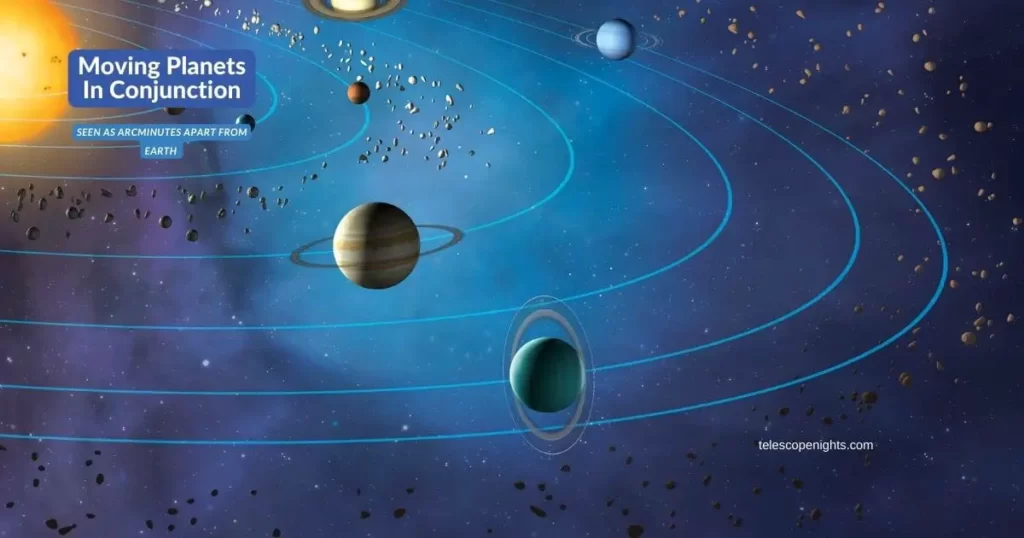
Key takeaway about the meaning of conjunctions in astronomy:
*A conjunction is when two planets or a planet and the Moon or Sun align from Earth’s perspective.
*Solar conjunctions are impossible for us to see.
*Moon and planet conjunctions occur throughout the month, every month, as the Moon passes each planet during that time.
*Rare and interesting conjunctions include the planets in The Great Conjunction and when several align.
When I started into stargazing and reading astronomy guides, I found some terms a little tricky. For me, at the time, I took a stab in the dark but knew I was missing out fully. Conjunction was one of these terms with inferior vs superior conjunctions and then it had other meanings as well.
Getting to know the topics more helps with experience and enjoyment of backyard astronomy. So, I’ve put together the following from what I’ve discovered about conjunctions.
Astronomy conjunctions of interest
For a backyard astronomer, conjunctions of interest could include seeing two planets meeting or the Moon and a planet close to each other in the sky…having the same RA (right ascension) or ecliptic longitude. See my article on How to Read Sky Coordinate Systems.
Consider [a right ascension] the same as you would a longitude on the Earth’s surface but instead on the celestial sphere.
Telescope Nights, How to Read Sky Coordinate Systems
Where you are located will affect what you see. As astronomy educator and author, John Mosley, points out… “a conjunction looks different from different locations on Earth because of parallax”. (Something to note.)
But if you source a guide for your location, it should give you the specs. An online one I’ve used: timeanddate.com.
Conjunctions are more amazing to observe using your binoculars when the two objects are close enough together to see them simultaneously. Or, with the extremely rare events, you get to see both through your telescope at the same time.
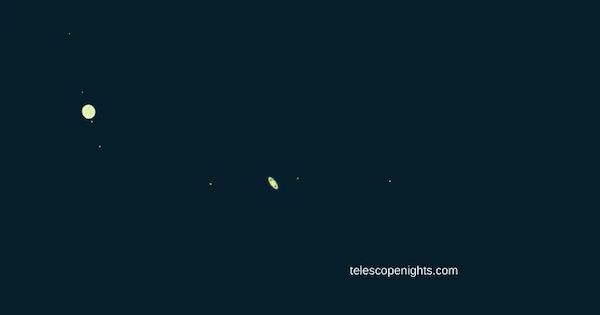
Sun conjunctions (inferior and superior)
This diagram explains conjunctions involving the Sun and the planets.
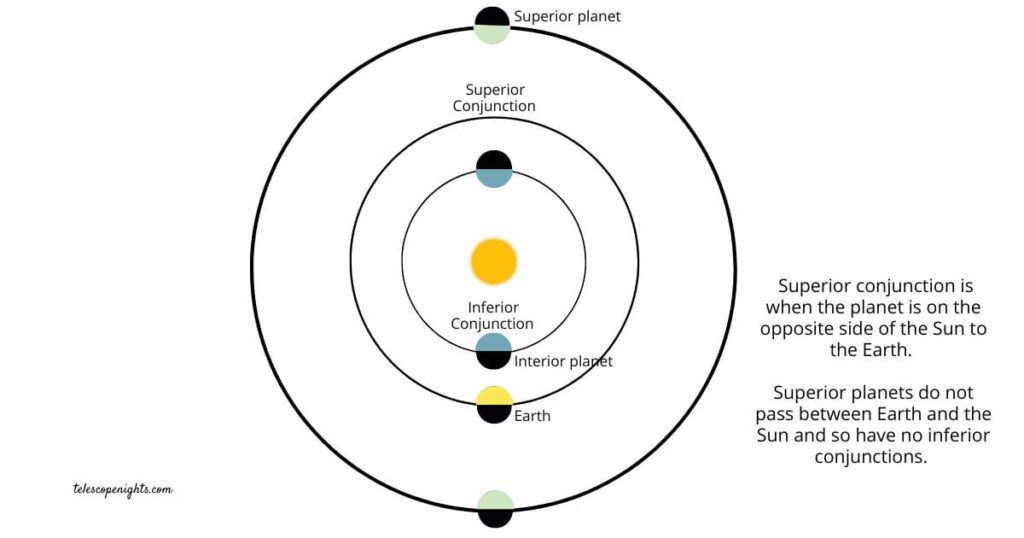
(Conjunctions of planets and the Sun are not for us, since the Sun is far too bright.)
The Great Conjunction
The conjunction of Jupiter and Saturn happens about every 20 years. But the Great Conjunction of these two outer planets seen in 2020 was far rarer…
The two giants, Saturn and Jupiter, in December 2020 impressed viewers around the world. They were a mere 6 arc minutes (or 0.1 degrees) apart in our sky. (Naturally, they are far far apart in space.)
The timing of this grand conjunction (according to Sky & Telescope):
- 1563
- July 1623
- December 2020
- March 2080
- 2417
- 2477
2020 was an extremely rare occasion, being the closest Great Conjunction since July 16, 1623, four centuries ago! At that time they were even closer at 5 arc minutes apart (~0.083 degrees).
The next really close Great Conjunction of these planets is expected March 15, 2080, passing 6 arc minutes apart (0.1 degrees).
With a conjunction this close, it’s possible to see the two planets together through a telescope. As I wrote in my article explaining field of view, a low-power telescope roughly shows 0.5° (30 arc minutes), and a high power one, 0.166° or 10 arc minutes of the sky (a rule of thumb).
The live video recording of the event observed through a telescope...
Planetary Alignment
Technically a planetary conjunction never involves more than two planets. But three or more planets can group together in an alignment and informally get called a conjunction.
5 planets align with Moon
The five planets, Mercury, Venus, Mars, Jupiter, and Saturn aligning in June 2022 was the first in 18 years. Because of the spread, naked-eye viewing is best to see such planetary alignments.
More common planetary conjunctions
A conjunction between Jupiter and Mars occurs about every 26 months.
Jupiter and Mars meeting in the sky:
- June 2022
- August 2024
- October 2026
The planets most commonly in conjunction with others are Mercury and Venus because they have small orbits and ‘move’ quickly.
Venus and Jupiter were 0.6 degrees apart on May 1, 2022. It was best seen before dawn in the Southern Hemisphere. The conjunction of these two planets isn’t that rare. It occurs approximately once a year. So is one to look out for.
Lunar conjunctions
The more frequent conjunctions involve those of the Moon as it passes each planet during each month.
June 2022 as an example: the Moon passed by Saturn on the 18th, Jupiter on the 22nd, Mars 23rd, Venus on the 26th and Mercury on the 27th.
Prominent examples for naked-eye observers are the Moon with Mars, Jupiter, and Venus.
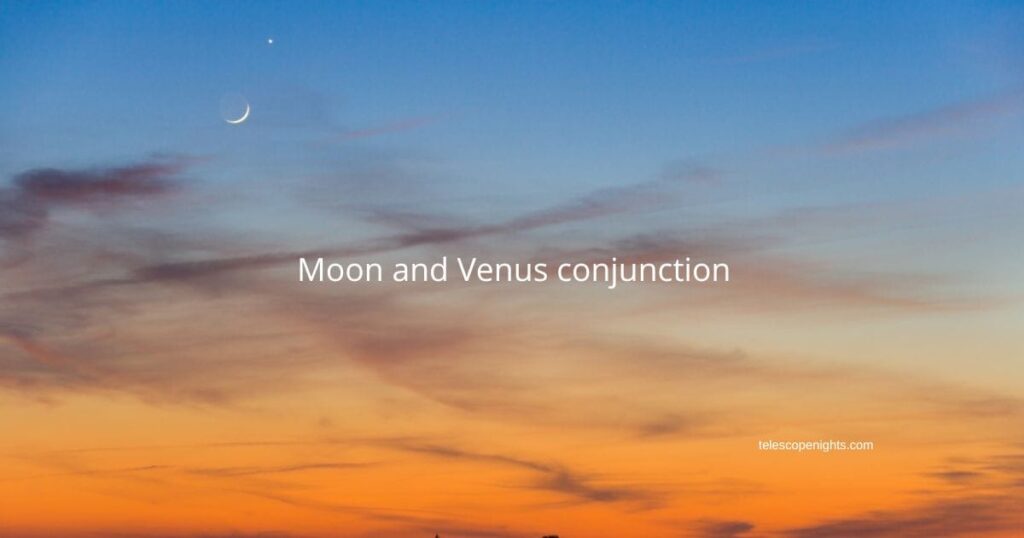
Final word
I hope the above has clarified the meaning of conjunctions in astronomy and you enjoyed the visuals. I find they help in explaining things. As you can see, there is more than one type of conjunction and some are more rewarding to observe than others.

